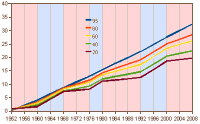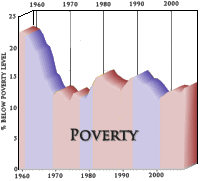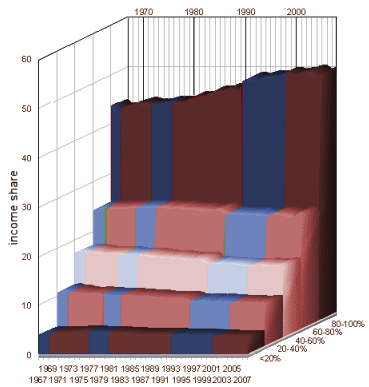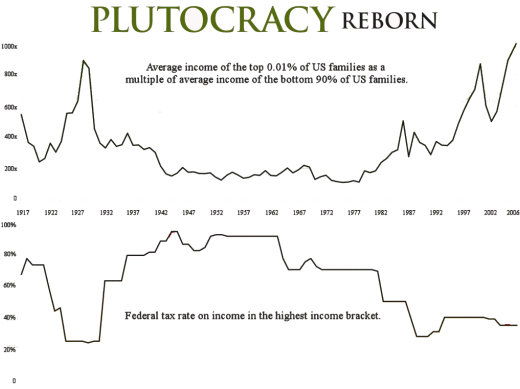"… you can’t really demonstrate that U.S. tax policy had a large impact on the three-decade income inequality trend one way or the other. The inequality trend for pre-tax income during this period was much more dramatic. That’s why academics concluded that government policy didn’t affect U.S. income distribution very much.…""… in recent years a few prominent economists and political scientists have suggested looking at the question somewhat differently. Rather than consider only effective tax rates, they recommend that we look at what MIT economists Frank Levy and Peter Temin call ‘institutions and norms.’ It’s somewhat vague phrase, but in practice what it mostly means is ‘stuff the government did, or didn’t do, in more ways than we can count.’ In his 2007 book, The Conscience of a Liberal, Princeton economist and New York Times columnist Paul Krugman concludes that there is ‘a strong circumstantial case for believing that institutions and norms … are the big sources of rising inequality in the United States.’"
"… the great reduction of inequality that created middle-class America between 1935 and 1945 was driven by political change; I believe that politics has also played an important role in rising inequality since the 1970s. It’s important to know that no other advanced economy has seen a comparable surge in inequality. …"
"Proponents of this theory tend to make their case not by measuring the precise impact of each thing government has done but rather by charting strong correlations between economic trends and political ones. In his 2008 book Unequal Democracy, Larry Bartels, a Princeton political scientist, writes: …"
"[T]he narrowly economic focus of most previous studies of inequality has caused them to miss what may be the most important single influence on the changing U.S. income distribution over the past half-century—the contrasting policy choices of Democratic and Republican presidents. Under Republican administrations, real income growth for the lower- and middle-classes has consistently lagged well behind the income growth rate for the rich—and well behind the income growth rate for the lower and middle classes themselves under Democratic administrations. …"
Jacob Hacker and Paul Pierson, political scientists at Yale and Berkeley, respectively, take a slightly different tack. Like Bartels and Krugman, they believe that government action (and inaction) at the federal level played a leading role in creating the Great Divergence. But the culprit, they say, is not so much partisan politics (i.e., Republicans) as institutional changes in the way Washington does business (i.e., lobbyists). "Of the billions of dollars now spent every year on politics," Hacker and Pierson point out in their new book, Winner-Take-All Politics, "only a fairly small fraction is directly connected to electoral contests. The bulk of it goes to lobbying…." Corporations now spend more than $3 billion annually on lobbying, according to official records cited by Hacker and Pierson (which, they note, understate true expenditures). That’s nearly twice what corporations spent a decade ago.According to Hacker and Pierson, industry began to mobilize in the early 1970s in response to liberalism’s political ascendancy (which didn’t end when Richard Nixon entered the White House in 1969):
The number of corporations with public affairs offices in Washington grew from 100 in 1968 to over 500 in 1978. In 1971, only 175 firms had registered lobbyists in Washington, but by 1982, 2,500 did. The number of corporate [political action committees] increased from under 300 in 1976 to over 1,200 by the middle of 1980. […] The Chamber [of Commerce] doubled in membership between 1974 and 1980. Its budget tripled. The National Federation of Independent Business (NFIB) doubled its membership between 1970 and 1979.
The resultant power shift, they argue, affects Democrats and Republicans alike.…
Next: Did the decline of labor unions create the Great Divergence?
 The differential in growth rates depending on the political party of the President is an impressive factor unto itself. This is my projection over the years they compiled. The divergence based only on these numbers is impressive. Remember, this way of looking at things doesn’t look at "why?", it only looks at "what?"
The differential in growth rates depending on the political party of the President is an impressive factor unto itself. This is my projection over the years they compiled. The divergence based only on these numbers is impressive. Remember, this way of looking at things doesn’t look at "why?", it only looks at "what?"  They also looked at the change in income tax structure that started with President Reagan – "trickle down" economics. While that tax cut for the wealthy was a really big deal, they ruled it out as a cause of The Great Divergence because the divergence is even larger if you look at pre-tax income. Interestingly, poverty hasn’t changed dramatically.
They also looked at the change in income tax structure that started with President Reagan – "trickle down" economics. While that tax cut for the wealthy was a really big deal, they ruled it out as a cause of The Great Divergence because the divergence is even larger if you look at pre-tax income. Interestingly, poverty hasn’t changed dramatically.
Bartel’s methodology is interesting but fatally over-simplified. See here for my critique: http://sovereignmind.wordpress.com/2010/09/11/how-to-mislead-with-charts-whos-responsible-for-the-great-divergence/



Bartel’s methodology is interesting but fatally over-simplified. See here for my critique: http://sovereignmind.wordpress.com/2010/09/11/how-to-mislead-with-charts-whos-responsible-for-the-great-divergence/
Mike,
See my update…
[…] Innocent 3. Importing Inequality 4. Computer Exceptionalism wealth inequity revisited… more about wealth inequity… 5. Too Many Republicans wealth inequity: big labor got small… 6. The Great Divergence […]
[…] point that the data presented comp[aring Democrats and Republicans was flawed [more about wealth inequity…[updated]]. But before looking at Noah’s comments about the Conservative arguments, I’d like to […]